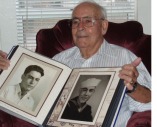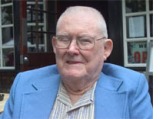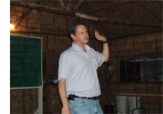 Dave Callahan saw the first nuclear bomb test on Bikini Atoll in 1946. Just a few miles from the blast in a landing craft vehicle he also had one of the best views. “Too close,” he said thinking back 60 years about his view from a U.S. Navy landing craft seven miles from the blast.
Dave Callahan saw the first nuclear bomb test on Bikini Atoll in 1946. Just a few miles from the blast in a landing craft vehicle he also had one of the best views. “Too close,” he said thinking back 60 years about his view from a U.S. Navy landing craft seven miles from the blast.
Callahan was one of some 42,000 military personnel and civilians who were witness to Operation Crossroads, an experiment in preservation. After World War II the Navy feared it may lose its budget since an Army airplane had dropped atomic bombs on Japan. Some thought the future of war would render a navy unnecessary.
In March of 1946 the United States moved 167 natives off Bikini Atoll and spread a fleet of abandoned ships in the lagoon. On July 1, test bomb Able was dropped and exploded over Bikini.
At his home in Citrus Heights, Calif., Callahan said seeing a nuclear bomb affected him more than anything else during the war. That included participating in nearly 20 island invasions, including Guadalcanal and Iwo Jima. He knifed to death a sentry on Makin Island during the Gilbert Islands raid, an experience that horrified him for many years.
 The 80-year-old native of Arizona volunteered for the Navy at age 16, younger than the legal requirement. “In those days they filled out a birth certificate in pencil,” Callahan explained in a December, 2005, interview.
The 80-year-old native of Arizona volunteered for the Navy at age 16, younger than the legal requirement. “In those days they filled out a birth certificate in pencil,” Callahan explained in a December, 2005, interview.
After the war he accepted the chance to attend Operation Crossroads, the first post-war testing of nuclear bombs. “None of us had heard of Bikini,” he said. Callahan was part of the underwater demolition team that blasted coral and set anchors for ships in the Bikini lagoon.
An atoll is a sunken volcanic ridge. Islands form a chain that surrounds a lagoon that is shallower than the ocean floor outside the reef. The natives say they liked it because fishing in the protected lagoon was safer. If they got bored on an island they could spend several days on one of the 22 other islands in the atoll.
Callahan arrived about the time the natives were being evacuated. They were loading their outrigger canoes and other possessions onto a Navy ship and left for Rongerik, an atoll 125 miles to the east, in early March. He remembered them as smiling, happy people.
“All of the islanders – when you go to one of their villages – would start singing ‘You Are My Sunshine’ … all over the Pacific, they did that. I don’t know why, but they did, and it was always fun.”
Memories are mixed as to whether military personnel were supposed to mingle with the Bikinians. Some published historical records say they weren’t but that it was hard to enforce. Callahan remembered going ashore to ask if they had “wine and women, or whatever.”
 Amid the beach parties and volleyball games for sailors, author Theodore Taylor said he remembered meeting a boy named Sorry, a name he used for the protagonist in the book he wrote 50 years after his experience at Bikini Atoll. The Bomb is a fictionalized account of a Bikini family during the time the U.S. asked if the Bikinians would temporarily move from their home.
Amid the beach parties and volleyball games for sailors, author Theodore Taylor said he remembered meeting a boy named Sorry, a name he used for the protagonist in the book he wrote 50 years after his experience at Bikini Atoll. The Bomb is a fictionalized account of a Bikini family during the time the U.S. asked if the Bikinians would temporarily move from their home.
“It was really a silly operation,” Taylor said in a December telephone interview from his Laguna Beach home, disgusted that the U.S. tested bombs in the Marshall Islands. “We already knew what would happen if you dropped a bomb on a Japanese city, which we did. The only people who did not know were the natives of Bikini.”
Today in the Bikini Town Hall on the island of Majuro, a Bob Hope quote is displayed: “As soon as the war ended, we located the one spot on Earth that hadn’t been touched by war and blew it to hell.”
Motion picture footage from the time shows military officers asking the Bikinians through an interpreter speaking Marshallese if they accept their request. Juda, the Bikinian leader says they will go, acknowledging, “Everything is in God’s hands.” The scene is repeated many times for the camera as is the Bikinians saying goodbye to their ancestors in the Bikini cemetery.
“There was an actual vote of the families,” said Taylor. “I think there were 11 families on the atoll. The family I write about in The Bomb voted against leaving the atoll.”
 Los Alamos still photographer Bill Regan volunteered for Operation Crossroads and remembers he wasn’t supposed to meet the natives, he said, reminiscing over lunch in a San Jose restaurant last October. He now lives with his daughter in Sherwood, Ore. “We weren’t supposed to but we managed to sneak a visit to some of the local residents. We weren’t supposed to take pictures, but I did.”
Los Alamos still photographer Bill Regan volunteered for Operation Crossroads and remembers he wasn’t supposed to meet the natives, he said, reminiscing over lunch in a San Jose restaurant last October. He now lives with his daughter in Sherwood, Ore. “We weren’t supposed to but we managed to sneak a visit to some of the local residents. We weren’t supposed to take pictures, but I did.”
Operation Crossroads was the biggest media event of 1946 with hundreds of motion picture and still cameras recording the spectacle. Regan photographed the first nuclear test from one of several airplanes circling the atoll. The operation used so much film it created a worldwide shortage for several months, even affecting Hollywood. “I can tell you it’s true,” said Regan.
“It was the most amazing site, that whole operation,” Callahan said. He remembered the USS Nevada painted bright orange as a target for the bomb drop, a contrast to the grey ships they lived on during the operation. More than 70 war ships were strategically anchored over miles throughout the lagoon – a few miles in diameter – to later assess damage and radiation. Included for symbolic revenge were the captured Japanese battleship Nagato, from which the attack on Pearl Harbor was ordered, and German cruiser Prinz Eugen.
Controversy surrounded the need for the tests. Constituencies in the U.S. protested against using ships such as the USS Saratoga in an operation that was intent on their destruction. In his book Operation Crossroads, author and lawyer Johathan Weisgall illustrates the Navy’s intent to demonstrate their continued relevancy in the face of a possible budget slash. With an Army airplane dropping previous nuclear bombs, the Navy needed a demonstration of how it could use the new technology.
After considering test sites in the Atlantic and the Caribbean, the U.S. chose Bikini for its remote location – halfway between Hawaii and Australia – and few natives to relocate. The Bikinians had lived through brutal treatment under the Japanese military during World War II. The Japanese committed suicide upon the arrival of U.S. Marines, who gave the Bikinians food and medical attention.
 Jack Niedenthal, current Bikini trust liaison, remembered Bikini elders telling of the United States’ request. “‘They had hats and stars and guns, and they had taken out the emperors of the universe. We weren’t going to say no,’” Niedenthal said in a speech to the Mieco Beach Yacht Club on Majuro in January.
Jack Niedenthal, current Bikini trust liaison, remembered Bikini elders telling of the United States’ request. “‘They had hats and stars and guns, and they had taken out the emperors of the universe. We weren’t going to say no,’” Niedenthal said in a speech to the Mieco Beach Yacht Club on Majuro in January.
The original inhabitants didn’t say “no” either. In the late 1700s or early 1800s, according to Niedenthal, Larkelon and his followers from Wotje Atoll – through whom today’s Bikinians are descended – challenged the original Bikinians from the shore. The natives surrendered and left. Land in the Marshall Islands is worth war, said one Bikini elder now living on the island of Ejit in Majuro Atoll. Two and a half centuries later the current Bikinians found themselves in the same situation – leaving without a fight.
Bikini is an old Marshallese term meaning “land of many coconuts,” said Niedenthal. Elders said it’s correctly pronounced with emphasis on the first syllable.
At the time of Crossroads, some were passionate against moving the locals for nuclear tests. Others don’t remember feeling bad. Author Taylor, a reserve lieutenant, is of the former mindset. “None of us on that ship – after meeting the natives, after seeing how they lived – wanted that bomb dropped,” said Taylor. “None of us.”
Taylor dismissed the whole operation as a promotion by an atomic scientist. “Not too much time had passed between our bombs on Japan. … We already knew all that information.” Some scientists, he remembered, were against the need to drop a bomb on “that absolutely gorgeous atoll.”
If he could ask the U.S. government any question: “Why we did it. That’s a question I could have asked 50 years ago in Washington and been told to get my nose out of it.”
“Smiles and laughter and happiness,” said Taylor remembering the Bikinians.” I remember that part of it before we shipped them away. They were just wonderful, wonderful people.”
“The day we shipped them out, every sailor lined up on the ship to wave goodbye.” A booklet about memories of the atoll was produced on the ship’s printing press. “It was a heartfelt expression about the atoll and the people who lived on the atoll,” said Taylor.
“We attended lectures in the evening,” Callahan recalled, “and they had all these what we’d call ‘longhairs.’ They were actually physicists is what they were, kind of a derogatory term we used, you know. They gave us lectures about, you know, what to expect and how wonderful the atomic age was going to be.”
Callahan said he didn’t believe them. “Most of us didn’t. Not for any reason that I would have now to not believe them. We had just been through four years worth of war, and it’s pretty hard to become everything lovely and dovely now. … But they told us all the wondrous things that ships would be powered with atomic power. Most of us are sneering, ‘yea sure.’
“One night … right in the middle of this [lecture], you know, about what atomic fusion was, which went right over most of our heads, … he said, ‘We sincerely hope that this does not set off a chain reaction in the atmosphere and just go right around the world and destroy the world.’ Well that made most of us pretty nervous. Then we started talking about it among ourselves. … “We already knew three bombs had exploded already, all in the atmosphere, so probably things were all right.”
Members of Congress and representatives of the United Nations were seated several miles away for the U.S. military’s show of force as the world entered the Cold War.
On July 1, 1946, the airplane Dave’s Dream dropped test shot Able over Bikini lagoon, the world’s fourth atomic bomb. “Bomb away,” said a voice on the speakers in ships as well as on radios broadcasting live throughout the United States.
Taylor was eight miles away and remembers watching it fall. The 21-kiloton blast – equal to the “Fat Man” bomb dropped on the Japanese city Nagasaki – had “many, many colors to it.”
“Red and green and purple and white and pink and orange, and just multi-multi-colored,” remembered Callahan.
“We were told not to look at it,” said Taylor, “which was totally stupid because everyone wanted to see what it looked like. Hell, we were out on deck, and you couldn’t help but look.”
He felt a shockwave that can be seen rattling palm trees in motion picture footage. “It would be like Katrina, really,” said Taylor.
Callahan had Navy-issued goggles. “You could look at the sun and couldn’t see anything but a little rim. You could hold your hand out in front of you and couldn’t see it. That’s how dark those things were. I thought, ‘Well this is really going to be good, we’re blindfolded.” Then he saw the blast.
“The sight of this thing was just absolutely, horrifyingly beautiful. You could recognize the power of this thing,” Callahan said. “Kind of an evil beauty.”
The cloud drifted away and 20 minutes later his crew went in. Knowledge of radiation was still developing. Callahan remembers the USS Independence on fire. On another ship he remembers many of the lab animals used as experiments lying dead.
“When you get up close and see the awesome power that that thing had, it made us all very nervous. It was very interesting, but you always had a feeling of, ‘Good God what have we done now?’ ”
Three weeks later the Navy proved its capability with test Baker, another 21-kiloton blast, this time from 90 feet under water. It threw a column of water 2,000 feet wide more than a mile high. Reports say the base surge was 94 feet and waves four miles away were still six feet high. The USS Arkansas was at the bottom of the lagoon within minutes. The USS Saratoga took eight hours to join it. Baker sank seven ships. The third test, Charlie, was canceled, which ended Operation Crossroads.
Years later some Navy veterans died of complications related to radiation. Callahan never experienced anything abnormal and doesn’t know why. He’s glad to be healthy.
Four days after test Able, French designer Louis Reard introduced a two-piece swimsuit. Perhaps riding on media attention using shrewd marketing, he called it the “Bikini.”
A year and a half after Crossroads, an American anthropologist visited the Bikinians on their temporary home Rongerik, an atoll with one-fourth the land space and lagoon of Bikini. They were malnourished and near starvation. They were evacuated to Kwajalein where they lived next to a landing strip. Other nearby atolls were inhabited and they voted for a move to Kili – a deserted island surrounded by open ocean and no lagoon. Its surface area is about one-third of a square mile compared to the once 3.6 square miles and some 20 islands of Bikini. About one-third of Bikinians still live on Kili.
Twenty-three nuclear tests were shot at Bikini intermittently for 12 years. The Atomic Energy Commission declared it safe in 1969. Some Bikinians, mostly those with larger land rights, returned. In the 1970s they were found to have ingested cesium-137 from locally grown food. Much of the “poison,” as they call radiation, was from the 1954 Operation Castle, which included the 15-megaton blast Bravo, the largest nuclear bomb detonated by the United States.
Today the same issue remains: The atoll is safe for inhabitants provided they don’t eat the locally grown food for an extended period of time.
In the 1970s, published reports from Lawrence Livermore National Laboratory found that a fish in Bikini had no more toxins than a fish purchased on the market in Chicago. Radiation in the water has dissipated. Scientists say a person is exposed to more background radiation in the U.S. than in Bikini and the Marshall Islands. People visiting Bikini are exposed to more radiation on the plane getting there than during their visit. Niedenthal said that if radiation were the issue, he would rather live in Bikini versus a high-altitude city such as Denver.
Bikini is vacant now except for a SCUBA diving program accommodating 11 guests per week. It operates throughout the year providing guests with world-class diving as well as a historical lesson of what happened there in the 1940s. The dives are accompanied by guides to assure safety for the divers as well to prevent the removal of souvenirs. The ships still contain the articles left before they sunk, unlike the stripped vessels under the Chuuk lagoon. Divers can see cars, airplanes, coffee mugs, shaving mirrors, even a bugle.
Bikini diving is booked a year in advance, with 2006 sold out as is most of 2007. This year is the program’s 10th season.
The deck of the USS Saratoga at 100 feet is the shallowest dive. The deepest is 170 feet under the Japanse Nagato – the battleship where Admiral Yamamoto ordered the attack on Pearl Harbor.
Diving Bikini requires open water certification and 50 dives. Niedenthal said the water averages 83 degrees with 100 feet of visibility.
The Bikinians own the ships after the U.S. ceded them following the end of testing there in 1958.
March 31, 2011 at 1:08 am
Searched the google and discovered your internet site.!!!.I should say i’m really impressed and this data just arrived quite handy. I will bookmark and join rss feed. realy wonderful post thanks for sharing